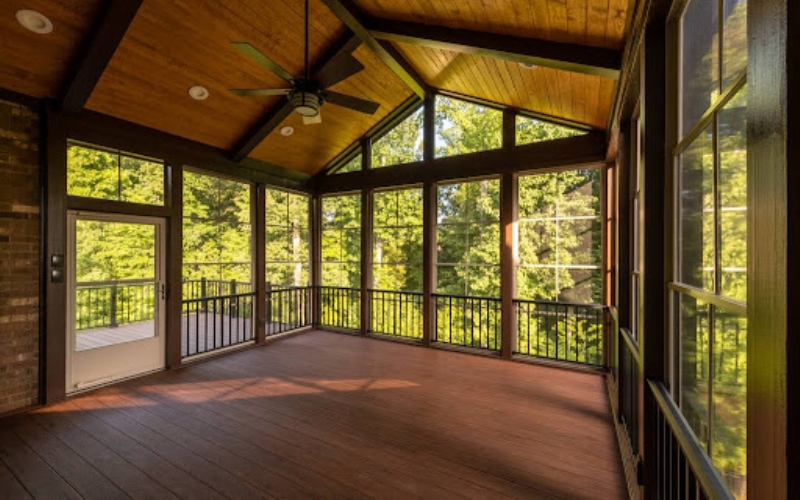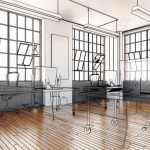Frameless windows, also known as seamless or direct set windows, are window types without sash or frame elements, providing an unobstructed view. They give properties a modern, sleek finish with their minimalistic structure. Usually designed with tempered glass for durability, frameless windows are highly prized for their ability to maximize natural light ingress.
Frameless windows originated in the 20th century, during the modernist architecture movement when designers emphasized sleek lines and unobstructed views. Architects such as Mies van der Rohe pioneered this aesthetic in buildings like the Farnsworth House. Their popularity has recently surged in modern home design for their minimalistic yet luxurious appeal. For more information, you can visit this link: https://www.sapphire.com.sg/.
Understanding the Architecture of Frameless Windows
Frameless windows often use tempered or laminated glass for safety and durability. Tempered glass, heat-treated to be four to five times stronger than standard glass, resists breakage, and when it does break, it shatters into small pebbles. Laminated glass consists of two glass layers with an intermediate plastic layer, which remains intact even upon breaking.
When designing any product, size and design are paramount considerations. Size affects utility, portability, and cost, while the design impacts aesthetics, functionality, and user experience. An efficient design balances form and function, while size caters to varying consumer needs and preferences. Hence, these aspects influence a product’s market acceptance and success.
The installation process involves setting up applications or systems onto a device. It includes downloading the software, accepting terms and conditions, selecting preferences, and integrating the software into the existing system. Errors during this process could lead to functional issues, hence careful execution is essential for optimal performance.
Advantages of Frameless Windows
Boosting aesthetic appeal is crucial in various domains, from product design to personal grooming. It involves enhancing visual allure to captivate attention. Incorporating colours, patterns, textures and innovative designs helps achieve this goal. This enhancement can influence perceptions and decisions, making a person, object, or environment more attractive and appealing.
Maximal light penetration refers to the ability of light to penetrate or pass through a medium to the greatest possible extent. It is crucial in areas such as photography, vision science, and particularly in marine biology where sunlight’s penetration depth significantly influences aquatic ecosystems. Achieving maximal light penetration ensures optimal visibility and energy transmission.
Perched on the edge of a cliff, my cabin offered an environment of solace characterized by uninterrupted views. With the horizon stretching infinitely, the view was a seamless blend of sky and sea. Sunrises painted the canvas of the morning and faded into clear days which then succumbed to starry nights.
The endless possibilities of customization can transform any product, idea or service, making it unique and personalized. Customization enhances user experience by matching specific needs and preferences, driving customer satisfaction and loyalty. It offers flexibility, innovation, and specificity ranging from tailored clothing to personalized web content.
Energy Efficiency of Frameless Windows
Maintaining temperature balance is pivotal for organisms’ survival and overall health. It ensures optimal bodily functions, such as metabolism and cellular activities. Humans, for instance, maintain this balance through thermoregulation, where our hypothalamus, as the body’s thermostat, regulates heat production and heat loss to maintain our core temperature.
Sustainability involves the prudent use of resources to maintain ecological balance. Everyone can contribute to sustainability through simple acts such as reducing waste, recycling, and reusing. Adopting energy-efficient practices, supporting renewable energy, and planting trees also make a significant difference. Each individual’s effort greatly contributes to promoting global sustainability.
Cost savings are critical for the financial health of any organization. They involve reducing expenses while maintaining the same level of product or service quality. This strategy benefits companies by increasing profitability, improving efficiency, and ultimately providing more value to customers. Implementing cost-saving measures requires effective planning and strategic decision-making.
Frameless Windows in Modern Home Designs
Minimalistic home styles utilize simplicity and functionality. In these applications, the design often features a stripped-back colour palette, functional furniture and subtle elegance. This style is based on the principle of ‘less is more’, appointing only essential items, thus promoting an uncluttered, peaceful living environment.
Industrial and contemporary designs land a unique visual appeal to various structures. Industrial design emphasizes structural elements, bringing an aged, raw aesthetic. Contemporary design, on the other hand, is all about clean, smooth lines, simplicity and functionality. Both are increasingly used to create impressive interiors, buildings, furniture and products.
Maximizing small spaces is vital in managing efficient living and working environments. It involves strategic planning to utilize limited space effectively, promoting cleanliness and organization. This adds value by creating versatile areas, reducing clutter, and enhancing functionality. Hence, the importance of maximizing small spaces improves productivity, convenience and overall quality of life.
Safety Considerations and Enhancements of Frameless Windows
Tempered glass is extensively used in various industries due to its high strength and safety features. It’s specifically designed to shatter into small granular pieces upon impact, reducing the risk of injury. Frequently used in automotive windows, shower doors and cookware, its resilience and durability offer essential protection against accidental breakages.
Additional safety features in products or systems serve to enhance user protection and security. They may include automatic emergency braking in vehicles, fingerprint recognition in smartphones, or auto-shut-off in appliances. Such inclusions aim to prevent accidents, provide timely intervention during emergencies, and ensure peace of mind for users.
Maintenance requirements are crucial elements for any machinery or equipment to ensure efficient performance and longevity. They may include regular inspections, cleaning, repairs, or replacements of worn-out parts. Not adhering to these requirements may result in poor functionality, increased costs, and potential safety risks.
Market Trends for Frameless Windows
The current state of the market is largely unpredictable due to various factors such as the ongoing pandemic, changing government policies, and volatile investor sentiment. Despite these uncertainties, the technological, healthcare, and logistics sectors continue to thrive. However, the hospitality and travel industries are struggling to recover. Overall, it’s a mixed market condition.
The future is expected to be dominated by remarkable advancements in technology. Artificial intelligence and automation will redefine many sectors, including education, healthcare, and transportation. The focus will shift towards sustainable energy, intelligent infrastructure and space exploration. Lastly, virtual and augmented reality will add a new dimension to our lives.

Conclusion
Frameless windows represent a contemporary and aesthetically pleasing architectural choice, offering unobstructed views and a sleek, modern finish. Originating from the 20th-century modernist movement, these windows have seen a resurgence in popularity in today’s modern home designs for their minimalistic and luxurious appeal.
Understanding the architecture of frameless windows emphasizes the use of tempered or laminated glass for safety and durability. The installation process involves precise measurements and careful integration into existing structures, ensuring optimal functionality. The advantages of frameless windows include boosted aesthetic appeal, maximal light penetration, and endless possibilities for customization.
Frameless windows also contribute to energy efficiency by allowing optimal light penetration and maintaining temperature balance. Sustainability and cost savings are additional benefits, aligning with the principles of resource conservation and financial prudence. In the context of modern home designs, frameless windows complement minimalistic styles, industrial designs, and strategies for maximizing small spaces.





